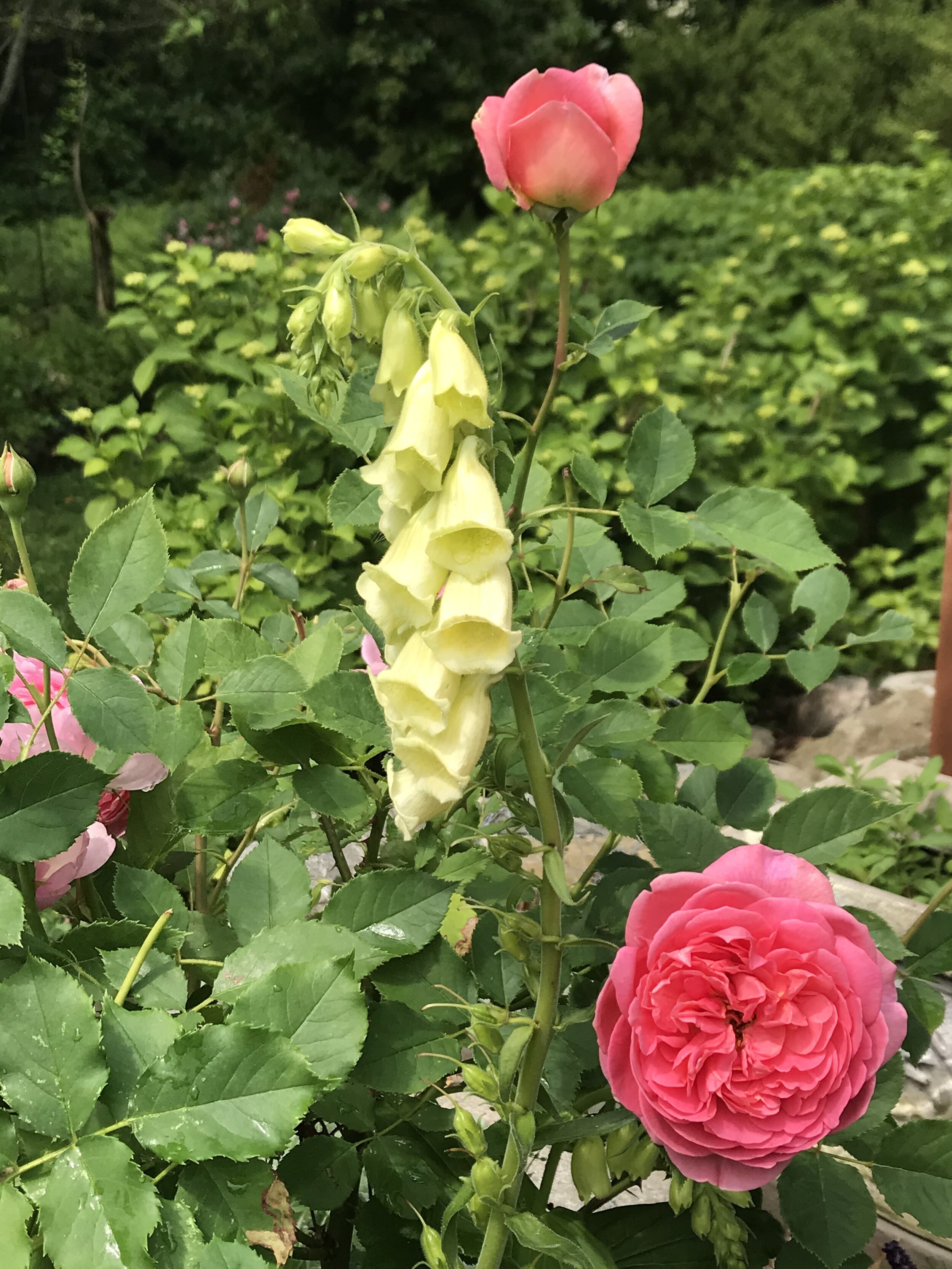Reveling in Roses
How to simplify having roses part of your garden
Climber Lady of the Lake, a David Austin rose
I don’t know anyone who doesn’t love roses; they are surely my favorite flower! I have to admit though, I swore them off many years ago when I was just starting out in my garden. I tried a few big store roses that never made it through the winter, rarely flowered or were disease ridden. With 3 young boys trampling through my beds, they definitely were not worth the trouble! Fast forward a decade or so and my garden has over 50 roses, blooming from the end of May through October! These roses, (and their pitiful predecessors!), taught me one main principle of successful, simple rose growing:
Healthy roses make happy roses!
Yes, I know how simple it sounds….but follow these few rules and your garden will be filled with the heavenly scent of roses!
Start with high quality roses…
I bought almost all of my roses from HeirloomRoses.com or DavidAustinRoses.com. Heirloom Roses sells only virus free, one year old, own root roses. At a year old, these roses come in a small pot, so are easily planted any where, (pots, borders, etc), without a huge hole needed. Within 2 years, they completely catch up to larger bareroot or potted roses. In my neck of the woods where it can drop to below zero in the winter, there is unfortunately the possibility of a young rose dying back. With own root roses, the root system will regrow the rose you purchased. (Grafted roses have a rootstock grafted on to the flowering plant. They will not regrow the rose you purchased and the graft site can be more susceptible to freezing).
David Austin Roses are the quintessential English rose. Some of their roses are sold at HeirloomRoses.com, but I go directly to the David Austin website for a vast number of choices and their five year guarantee! Their roses are grown in Texas and can be purchased bareroot or potted, although, I don’t think the potted ones are worth the extra money. I found roses are happier the first year if planted in a dormant state as they are in bareroot.
Both of these nurseries categorize roses pretty accurately on their health and shade tolerance as well as size, scent, color and more. Choose your rose with these characteristics in mind. This leads me to rule 2!
2. Consider your rose’s characteristic’s and planting location….then adapt.
Ok, so you bought a not-so-healthy, but beautifully scented rose on impulse or the rose you desperately want is not a disease resistant type; or if the location you have for your new rose is not ideal, (6 hours of sun, no overhead watering, moist, but well draining soil), adapt your planting! Every rose needs a healthy start..I make sure I plant all new roses with plenty of composted manure and/or my own compost. For those disease prone but worth it roses, add a companion plant to hide the eventual bare canes when blackspot takes hold. I had to have Rosa Jude The Obscure, a David Austin rose that is wonderfully fragrant and a creamy yellow color. I placed my climbing version with a companion of the annual herb borage. I tossed in seeds after I placed my spring compost and fertilizer. It grew up through the canes, flowering an incredible blue and disguised the bare canes in September. There are other ways to hide the ugly “legs” of your must have roses planted in questionable locations including potted plants, perennials and groundcover. Chose perennials that can handle a springtime dressing of compost like perennial geraniums, lambs ear and even foxgloves! These are also distasteful to critters, so can hide and protect tender rose leaves in spring! I also grow some roses in beds where only the blooms peek through the standard cottage garden plants…peonies, poppies, and catmint to name a few. By August, these impulse bought roses are leafless, but completely hidden! Using groundcover, such as vinca, is perfect since it can be pushed aside to allow great air circulation in spring and allowed to grow if necessary later in the summer. So once chosen, positioned and planted, how can you keep them healthy and blooming without an intense maintenance regimen? Well, read on..
Princess Alexandra of Kent, a David Austin rose
Having roses in your garden may seem complicated and high maintenance, but read on to see how to simplify growing beautiful, fragrant roses.
Rosa Boscobel, a David Austin favorite.
This is an unknown rescued hybrid tea rose…It is really that neon! Does anyone know what it is?
Blackspot is a fungal disease that infects roses when its spores find damp, shady leaves. It starts from the base of the plant since the spores can be splashed up on the lower leaves where there is less air circulation. It then moves up the plant infecting the next higher up leaves. It can and will defoliate a whole rose bush, but rarely kills it. There are roses that are very immune to it and some that are very prone to it no matter the circumstances of the rose’s location or care.
3. Prune and feed in early spring and maybe…. spray
ALL roses should be pruned in the early spring when they are still dormant. This is a universal..except for large climbers I can’t get to…(a Paul’s Himalayan Musk!) The trick to pruning is knowing that all the “energy” that the rose had from being in the sun all summer is stored in the roots when the leaves fall off in the winter. If you trim off about a third of the rose height when pruning your dormant rose, there will be “energy” that has no canes to go back to in the spring. It is this “extra” energy that the rose uses to grow new canes and put into flower production. It can be scary to cut away so much, but it reinvigorates the rose. It is how professionals get their rose shrubs to be covered in blooms! All roses also get an early spring fertilizing and mulching with compost..I do it at the same time I prune. I call it their spring wake up call!
As far as spraying and further feedings, not all roses are treated equally! I categorize my roses into 3 types…disease prone, disease free and disease resistant. Oddly, I treat my disease prone and disease free the same! I mulch them with compost and feed them with a handful or 2 of Biotone Organic Rose food in their spring wake up. If I get to it throughout the summer and I can reach them in a bed, I try to feed them 2 more times. I don’t make a concerted effort to deadhead this group since they are deep in perennial beds to hide their bald canes or are self-deadheading! Many, such as my Rosa New Dawn, make rosehips when not deadheaded anyway!
The neem oil and fertilizer with a sample of the dreaded blackspot between 2 baby colombines!
Rosa Wise Portia, a disease free, fragrant hybrid tea rose.
Rosa Gertrude Jekyll pairs with allium perfectly!
Rosa Cloud Ten, A disease free self-deadheading, fragrant beauty!
The perfect companions! Climbing James Galway in the vase..a disease free 12’ climber for me.
All of the roses in this journal are from my garden…let me know if you have any questions about them!
EnglishGardenSupplies@gmail.com
Then there are my disease resistant roses. I should be more clear..many of my roses are disease resistant, but are treated as disease prone. My disease resistant higher maintenance plan is for my 5 “precious” roses..( and yes, that is a nod to the Lord of the Rings that I saw 100’s of times with my sons!!) As before, they are pruned and given their spring dressing of compost and Biotone. Since these roses are all specifically planted close to the house, feeding them 2 more times throughout the summer is simple, (I keep a bag of rose Biotone under a lounge chair). My precious 5 are the only roses that get sprayed. I use an organic neem oil that is an insecticide, miticide and fungicide in the half gallon size that is ready to spray. It sits next to the fertilizer ready to go! When I spray my 5, I spray from top to bottom, including the plants, mulch or groundcover at their base…I leave them dripping! The first spray comes after they are leafed out, but no open blooms, and second comes after the first flush of flowers is over, (coinciding with the second feed early in July). Do not spray if there are open blooms…protect all pollinators! These 5 also get any leftover spray that I made up for my apple trees or tomatoes…Captain Jack’s Dead Bug Spray and Neptune’s Harvest Seaweed fertilizer, (both are organic). Between spraying fertilizer and Biotone, my 5 are fed about 4 times, ending about 4 weeks before the first frost, (no need having the rose waste energy on new growth that is soon to be lost!) By the end of the season my Princess Alexandra of Kent, Boscobel, Gertrude Jekyll, Jude the Obscure and Lady Emma Hamilton are healthy and have bloomed continuously.
For those of us who are empty-nesters, having a “precious” rose, or 5, is no problem. However, there are dozens of disease free, wonderfully fragrant, perfectly sized roses in the exact color and with the most perfect name that you could imagine available … pick from these or be ready to disguise any bare canes!
Do you have a “precious” rose or a well loved, but well disguised rose?
Send us your pictures!
“ Your page on roses is the best information I’ve ever seen specific to growing them in our area, where there’s scant information on that. ”


















